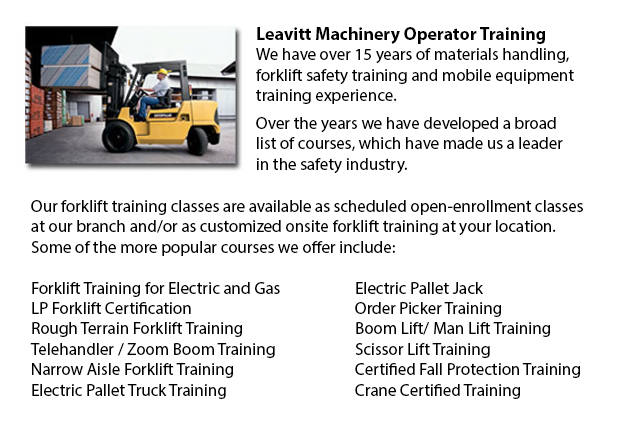
Forklift Training Schools Mississauga - What Are Covered In Our Forklift Training Schools
If you are searching for work as an operator of a forklift, our regulatory-compliant lift truck training Schools offer excellent instruction in many types and styles of forklifts, classes on pre-shift check, fuel types and handling of fuels, and safe utilization of a forklift. Hands-on, practical training helps participants in acquiring essential operational skills. Program content comprises current rules governing the utilization of lift trucks. Our proven forklift courses are designed to offer training on these kinds of trucks: counterbalanced forklift, powered pallet trucks and narrow isle forklift.
Do not raise or lower the fork whilst the lift truck is traveling. A load should not extend above the backrest due to the possibility of the load sliding back toward the operator. Check for overhead obstacles and make certain there is enough clearance prior to lifting a load. Stay away from overhead power lines. When the load is lifted straight up, tilt it slightly back.
The lift truck is less stable if a load is in a raised position. Make sure that no body ever walks underneath the elevated fork. The operator should not leave the lift truck while the load is lifted.
When handling pallets, forks should be high and level enough to go into the pallet and extend all the way below the load. The fork's width must provide even weight distribution.
Before loading or unloading the truck, chock the wheels and set the brakes. Floors need to be strong enough to support the weight of the forklift and the load combined. Fixed jacks could be installed to be able to support a semi-trailer which is not coupled to a tractor. The height of the entrance door must clear the height of the forklift by a minimum of 5 cm. Edges of rail cars, ramps and docks should be marked and avoid them.
-
Forklift Certification Courses Mississauga
Forklift Certification Courses Mississauga - Forklift certification courses really help to be able to make certain that businesses operating forklifts, follow the local and regional rules. The operators of the forklift must go through forklift certif... More -
Heavy Equipment Certification Mississauga
Heavy Equipment Certification Mississauga - Big pieces of machinery and heavy-duty vehicles are often referred to as heavy equipment. This broad term covers utility vehicles from agricultural and forestry implements to construction equipment, civil e... More -
Skid Steer Loader Training in Mississauga
The engine powered skid-steer loader has a rigid and small frame, outfitted together with lift arms that can attach to lots of industrial attachments and tools to perform numerous labor saving tasks. Usually, skid-steer loaders are four-wheel drive v... More -
Bucket Truck Training Mississauga
Bucket Truck Training Mississauga - The Vehicle-Mounted Aerial Work Platform or bucket truck training program is designed to decrease the possibility of incident and personal injury when working with or in close proximity to bucket trucks by efficien... More -
Scissor Lift Certification Mississauga
Scissor Lift Certification Mississauga - Scissor lift platforms are used at work locations to enable tradespeople - like for example welders, masons and iron workers - to reach their work. Utilizing a scissor lift platform is typically secondary to t... More -
Order Picker License Mississauga
Order Picker License Mississauga - Order preparation operation or order picking as it is more normally known is a process used within warehouse operations and comprises personnel called order pickers. The order picker's job is to take and collect art... More -
Forklift Train The Trainer Mississauga
Forklift Train The Trainer Mississauga - Our company provides the most advanced and latest Forklift Training courses in North America. We provide industrial workplace safety training, Train the Trainer, mobile equipment operator, and self study train... More -
Aerial Platform Training Mississauga
Aerial Platform Training Mississauga - Aerial forklifts are able to accommodate numerous odd jobs involving high and tricky reaching spaces. Normally utilized to execute daily maintenance in buildings with tall ceilings, trim tree branches, hoist hea... More

Forklift Training Mississauga
TOLL FREE: 1-888-254-6157
Mississauga, Ontario
forklifttrainingmississauga.ca
Email Us
About Us


